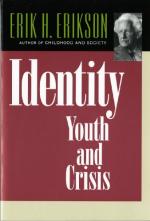
|
| Name: _________________________ | Period: ___________________ |
This test consists of 5 multiple choice questions, 5 short answer questions, and 10 short essay questions.
Multiple Choice Questions
1. What does Erikson's theory suggest concerning how children gain a sense of what their adult identities should be?
(a) By looking to community members.
(b) Learning about being an adult.
(c) It comes natural.
(d) Watching TV.
2. What is the core part of identity formation that cannot be separated from this formation?
(a) Authority acceptance.
(b) Collectivism.
(c) Individuality.
(d) Peace of mind.
3. Considering the relationship between personal and historical identity formation, how can this relationship be described?
(a) Psychosocial relativity.
(b) Genetic relativity.
(c) Psychosomatic confusion.
(d) Ancestral relativity.
4. What can reinforce the process of negative identity formation in terms of Erikson's stages of identity development?
(a) Biology.
(b) Negative parental reactions.
(c) Arrogance.
(d) Weak ego.
5. What does Erikson state that childhood and youth predispose men to?
(a) Structure.
(b) Childlike wonder.
(c) Confused identities.
(d) Totalitarianism.
Short Answer Questions
1. Since there were few empirical studies, how did Erikson's study individuals?
2. During Erikson's final stage of development, individuals having a sense of Generativity may engage in what type of activities?
3. According to Erikson, in his review and observations of changes in culture, what does he suggest will become common values among today's youth?
4. What does the success of identification during Erikson's stages of development depend on?
5. What does Shaw find his childhood exposures to have been?
Short Essay Questions
1. According to Erikson's discussion in Chapter 4, how might a culture contribute to identity confusion?
2. Considering group identity developing, in light of Erikson's stages of development, how do individuals make group decisions in order to ease the pressures of making difficult decisions?
3. What is the role of ideologies and identity development?
4. What are some unique characteristics discussed at the beginning of Chapter 4 concerning George Bernard Shaw?
5. How do parents trigger transference in the formulation of evil ego identity as children move through Erikson's developmental stages?
6. What is Erikson feel that the process of identity formation is the process of increasing differentiation?
7. When does Erikson state, concerning James and Shaw, that the adolescent process ended?
8. Considering Erikson's theory of identity development, how does the parent's tendency to remain stuck in adolescents affect youth's identity development?
9. Why does Erikson suggest that understanding identity requires understanding the development of identity?
10. How does Erikson think acute identity confusion manifests?
|
This section contains 863 words (approx. 3 pages at 300 words per page) |

|




